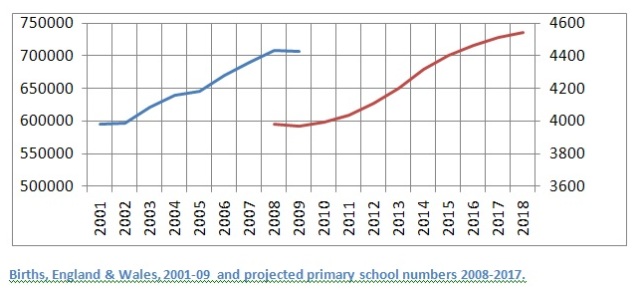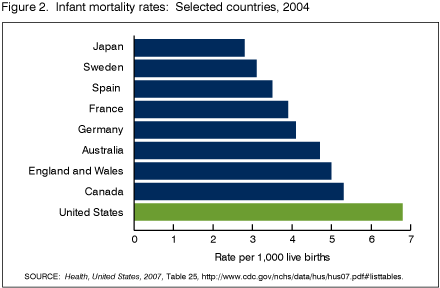Turning a blind eye to the birth rate
Statistics are supposed to inform debate, and guide policy. That’s why we collect them.
How is it, then, that after seven years of rising birth rates, central and local government has only just begun to respond?
A recent analysis in the Financial Times by its Education Correspondent Chris Cook (FT, December 1 2010) concluded that one in three English boroughs does not have sufficient primary school places to accommodate the numbers expected.
In 52 English local authorities there will be overcrowding in primary schools by 2014-15 unless building starts soon, Mr Cook says. A seven per cent rise in the primary school population will mean that if even the limited degree of parental choice of school is to be maintained, more than 350,000 new places will need to be provided – enough to consume half the capital budget of the Department of Education for the entire parliament.
Already 110,000 pupils are in schools that exceed the overcrowding criteria (4 per cent over capacity) and 42,000 children attend schools that are more than 10 per cent over their limits. Where there are spare places, they are in poorer schools that get worse results. So if Michael Gove, the Education Secretary, wants to maintain a degree of choice and provide enough places from a limited budget, he is going to have his work cut out.
Yet this crisis, like the crisis in maternity services that went before it, and the crisis in secondary schools that will probably follow it, has been predictable for years. A liberal immigration policy combined with rising birth rates among those already living in the UK to produce a boom in births. Roughly two thirds of these “extra” births have been to women born outside the UK, with the remaining third attributable to rising birth rates among women born here, according to an ONS study.
The increase first became evident in 2002, (see Chart 1) but nobody seems to have done much about planning for its consequences.
Chart 1 Births and Primary School numbers

The chart shows (left axis, blue curve) the number of births recorded by year between 2001 and 2009, and (right axis, red curve) the national pupil projections (in thousands) looking forward to 2018 and published by the Department of Children, Schools and Families (now Education) in March this year.
These projections use far more sophisticated methods than merely following the birth rate, but whether such sophistication was actually needed to inform policy is not at all clear. As the chart shows, and as common sense would suggest, there is a close parallel: the demand for places at primary schools starts rising about six years after the birth rate. It hardly needed a genius to work that out.
This projection by the former DCSF appears to be the first systematic attempt to work out future demand for school places in England, but it came too late. While spending on schools rose rapidly after 1997, it was dominated by the £45 billion Building Schools for the Future programme, which targeted secondary schools.
A capital programme for primary schools was announced in April 2009, with a first instalment of £1.9 billion up to April 2011, and a further £5.1 billion to follow. But by the time of this announcement the recession was already upon us and the days of public largesse were numbered.
It seems clear that too little attention was being paid in the years after 2002 to the implications of the rising birth rate. If ministers had been awake, primary schools rather than secondaries would have been prioritised for capital spending. State-funded secondary school rolls actually declined after 2004 and are expected to decline further until around 2015, when the primary school “bulge” feeds through.
The effects of rising births on maternity services are harder to measure, but show much the same deficiencies of planning. Many maternity units have been clinging on with too few staff, trying to keep up with rising numbers of births, while plans to recruit more midwives were slow to germinate and have yet fully to deliver.
While births have grown by 19 per cent over the past decade, midwife numbers have risen by 12 per cent. Mortality rates in the UK, unremarkable by international standards (see chart 2, taken from the US Centres for Disease Control and based on rather old WHO data), have continued to fall but at a much slower rate than in the 1980s. Infant mortality has fallen by two thirds since 1978, but the rate of decline was twice as fast in the first half of this period as in the second.

A recent survey by the Royal College of Midwives found evidence that in spite of the ringfencing of the NHS budget, staffing cuts were being made. The best hope of maintaining or improving standards lies in the slender evidence – a single year’s data – showing that the rise in births has now peaked. There were a few thousand fewer births in 2009 than in 2008, but it is too soon to discern a trend.




Robert Whiston (not verified) wrote,
Tue, 28/12/2010 - 22:59
The Conservative Party cannot say it was not pre-warned.
In 2005 I wrote a position paper for them entitled "Pensions, Proliferation and Propaganda" taking head on the then current and very fashionable view of a declining workforce (pro rata) and the future "impossibility" of pensions following publication of the reveiw by Adair Turner.
Robert Whiston (not verified) wrote,
Tue, 28/12/2010 - 23:08
I should perhaps add that the predicted trends in birth by 2030 and 2050 as forecast by the ONS was the basis of my paper. Their prediction saw a rise in birth rates albeit not as early as shown above, ie 2002 - 2008. Should this rise in births be followed by a further rise, starting in 2030 and 2050, then the arguments about the ratio of workers-to-pensioners becomes redundant.
R. Whiston